Herculaneum. Villa dei Papiri or Villa of
the Papyri or Villa dei Pisoni.
First excavated 1750-1761, accessed by a series of wells and tunnels.
Excavated again 1764-65, 1996-1998 and from 2008.
Part 1. Upper level: The complex and the atrium areas
Upper level Lower
levels Reconstructions Getty Villa and the Jashemskis Model Monumental structure Baths House
of the Dionysiac Reliefs and Pavilion Sculptures Frescoes Mosaics Plan
On this page: Bibliography Excavations The Villa dei Papiri complex Atrium part 1 Atrium part 2
Bibliography
Allroggen-Bedel, A. Il Museo Ercolanense
di Portici in Cronache Ercolanese supp. 2,
1983, p. 112.
Barker E. R., 1908. Buried Herculaneum. London: A and C Black.
Comparetti D. and De
Petra G., 1883. La Villa Ercolanese de
Pisone. Torino: Ermanno Loescher
Cooke, Cockburn, and Donaldson, 1827. Pompeii Illustrated:
Vol. 2. London: Cooke, pl. 52.
De Simone, A., Ruffo F. Ercolano
e la Villa dei Papiri alla luce dei nuovi scavi, Cron.
Ercol. 33 (2003)
De Simone, A., Ruffo F. I
mosaici della Villa dei Papiri ad Ercolano (NA). Il quartiere dell'atrio.
Atti del X Colloquio dell'Associazione Italiana per lo Studio e la
Conservazione del Mosaico, Lecce, 18-21 febbraio 2004.
Esposito D., 2010. Le Pitture della Villa dei Papiri ad
Ercolano in La Villa Romaine de Boscoreale et ses fresques, édicions errance: Musée royal de Mariemont
Esposito D. and Guidobaldi M., 2010. New Archaeological Research at the Villa of the Papyri, in the
Villa of the Papyri at Herculaneum. Berlin: De Gruyter
Gli ornati delle pareti ed i pavimenti delle stanze
dell'antica Pompei incisi in rame: 1796, 1808, and 1838.
Guidobaldi M. P., 2009. Ercolano: Guida agli scavi. Electa
Napoli.
Lapatin, K., Ed., 2019. Buried
by Vesuvius: The Villa Dei Papiri at Herculaneum. United Kingdom: J. Paul Getty Museum.
Maiuri, A., 2008. Cronache degli scavi di Ercolano, 1927-1961.
Sorrento: Franco Di Mauro Editore, (pp. 23ff)
Mattusch C. C., 2010. Programming Sculpture? Collection and Display in the Villa of the Papyri. In The Villa of the Papyri at Herculaneum. De Gruyter: Berlin, pp. 79-88.
Moormann E. M., 2009. Pitture parietali nella Villa dei Papiri a
Ercolano: Vecchi rinvenimenti e nuove scoperte, in Vesuviana. Archeologia a
confronto. Atti del Convegno internazionale (Bologna, 14-16 gennaio 2008
Museo Archeologico Nazionale
di Napoli: Rapporto annuale sulle attività del MANN: Annual Report 2018
Pagano, M. Mosaici romani nella reggia di Portici,
in: Atti del VII Colloquia dell'Associazione italiana per lo studio e la
conservazione del mosaico, Pompei, 22-25 marzo 2000, ed. by A. Papaccio, V. The floors of
the Villa dei Papiri. (p.56-63, of Buried by Vesuvius, the
Villa dei Papiri at Herculaneum, edited by Kenneth Lapatin).
Paribeni (Ravenna 2001),
esp. 337–338 and fig. 5 – 8.
Pesando, F. and Guidobaldi, M.P. (2006). Pompei, Oplontis, Ercolano, Stabiae. Editori Laterza, (p.292).
Villa Diomedes Project, Image database, http://villadiomede.huma-num.fr/bdd/images/5292
Waldstein C., 1908. Herculaneum Past Present and Future. London: Macmillan.
Wallace-Hadrill, A. (2011). Herculaneum, Past and Future. London, Frances Lincoln.
Excavations
1750: Villa of the Papyri, the finding of some buildings and a circular loggia recovered a precious flooring inlaid with polychrome marble (the same that today forms the flooring of a circular room of the Pinacoteca of Naples Museum). It was the belvedere of a garden of a patrician villa.
1752: The central body of the villa, and a second peristyle repeating in minor proportions the larger peristyle of the garden.
1753: The find that made Herculaneum known the world over, in a narrow room, almost humble, were arranged around the walls, on wooden shelves or closed in capsae or spilled on the floor, a large mass of cylindrical rolls. It was a library, a whole library of not less than 1800 Papyri mainly in Greek, but a lesser part in Latin.
1763: The excavation of the villa was not accomplished: the foul-smelling gas coming from the subsoil (the moféta) forced abandonment and in 1763, the mouths of the tunnels and the wells were closed preventing access and ventilation, the Villa dei Papiri or, as was said, the Villa dei Pisoni, descendants of that Lucio Calpurni Pisone Cesonino, who was Caesar's father-in-law and the enemy of Cicero, returned to the deep silence of its double shell of hardened mud and fire.
See Maiuri, A., 2008. Cronache degli scavi di Ercolano, 1927-1961. Sorrento: Franco Di Mauro Editore, (pp. 23ff)
According to Guidobaldi, there was a brief respite in 1764-5 when further excavation was carried out, before gas forced the closure of the access wells.
See Guidobaldi M. P., 2009. Ercolano: Guida agli scavi. Electa Napoli, p. 121.
During 1996-8, open-air excavations, the so-called Scavi Nuovi, were carried out in the area of the Villa of Papyri and the so-called North-west Insula.
See Pesando, F. and Guidobaldi, M.P. (2006). Pompei, Oplontis, Ercolano, Stabiae. Editori Laterza, (p.292).
According to Wallace-Hadrill, “until a modern campaign of excavations is carried out, the relationship between the Villa and Herculaneum will be limited. The 1996-1999 excavations only uncovered a corner of the villa, limited to the atrium area. By opening a vast trench to connect the villa to the main site and by taking the excavation down to the level of the ancient shore, it demonstrated that both the villa and the houses on the western edge of the town had lower levels reaching down to the shore. This excavation showed the magnificence of the lower terrace of the villa, with its pool close to the sea-shore. Simultaneously it demonstrated the splendour of the house at the western edge of the town, decorated with neo-Attic reliefs.
See Wallace-Hadrill, A., 2011. Herculaneum
Past and Present. London:
Frances Lincoln, p. 118.
The Villa dei Papiri Complex

Herculaneum Villa dei Papiri. October 2023. Looking west across site. Photo courtesy of Johannes Eber.

Villa dei Papiri complex, June 2014. Overview of site, looking west. Photo courtesy of Michael Binns.
From front to back are:
The double roof of the House of the Dionysiac Reliefs, seaside pavilion.
The paler coloured roof around the corner is the House of the Dionysiac Reliefs.
The tall building of the baths.
The white roof covering the collapsed monumental structure.
The levels of the Villa dei Papiri itself.

Villa dei Papiri, Herculaneum. 2006.
Excavation trench running to the Villa of the Papyri before conservation work. Photo by kind permission of Prof. Andrew Wallace-Hadrill.
See Wallace-Hadrill, A. (2011). Herculaneum, Past and Future. London, Frances Lincoln Ltd., p. 87.

Villa dei Papiri, Herculaneum. July 2004. Looking north-west. Photo courtesy of Jennifer Stephens. ©jfsPAP0658

Herculaneum Villa dei Papiri. October
2023.
Looking north towards baths complex, on left, and
residential complex, on right. Photo courtesy of Johannes Eber.

Villa dei Papiri,
Herculaneum. July 2010.
Looking north towards baths complex, on left, and residential complex, on right. Photo courtesy of Michael Binns.

Villa dei Papiri, Herculaneum. July 2010. Looking north-west along access ramp to villa. Photo courtesy of Michael Binns.

Herculaneum Villa dei Papiri. October
2023.
Looking west at south end. Photo courtesy of
Johannes Eber.

Herculaneum Villa dei Papiri. October 2023. Looking west. Photo courtesy of Johannes Eber.

Herculaneum Villa dei Papiri. October
2023. Looking north-west. Photo courtesy of Johannes
Eber.

Herculaneum Villa dei Papiri. October
2023.
Looking north-west to only excavated area of
the Villa that has been brought back into the open-air. Photo courtesy of Johannes Eber.

Herculaneum Villa dei Papiri. October
2023.
Looking north-west towards area of atrium on upper
floor above lower rooms. Photo courtesy of Johannes Eber.

Villa dei Papiri, Herculaneum. Plan of villa showing the only excavated area that is in the open-air (D) in thicker black lines.
See
Guidobaldi, M. P., 2006. Ercolano: guida
agli scavi. Electa Napoli, p. 122.
See Pesando F.,
Guidobaldi M., 2006. Pompei, Oplontis,
Ercolano, Stabiae. Roma: Laterza, p. 393.

Herculaneum Villa dei Papiri. October
2023. Ramps leading to lower and upper levels of
the villa. Photo courtesy of Johannes Eber.

Villa dei Papiri, Herculaneum. July 2010. Ramp leading to lower and upper levels of the villa. Photo courtesy of Michael Binns.
The atrium area
Villa dei Papiri, Herculaneum. Atrium level sketch plan. Based on 2006 plan by Pastore.
The room numbers are those used on these Herculaneuminpictures pages for this level of the villa.
See Pesando, F. and Guidobaldi, M.P. (2006). Pompei, Oplontis, Ercolano, Stabiae. Editori Laterza, (p. 398).

Herculaneum Villa dei Papiri. October
2023. Looking north-west from large loggia. Photo
courtesy of Johannes Eber.

Looking west across walkway (a), the large loggia, with white and black mosaic floor.
Foto Annette Haug, ERC Grant 681269 DÉCOR.

Villa dei Papiri, Herculaneum. July 2010. Looking west across walkway (a), the large loggia, with white and black mosaic floor.
From right, doorway to triclinium room (i), corridor (h), oecus room (g), room (b), corridor (t), room (s) and room (u).
Photo courtesy of Michael Binns.

Herculaneum Villa dei Papiri.
October 2023.
Looking north from threshold into room (i),
triclinium. The metal walk-way on the right is above the area of room (m).
Photo courtesy of Johannes Eber.

Villa
dei Papiri, Herculaneum. July 2010.
Looking north across triclinium, room (i), with coloured mosaic. Photo courtesy of Michael Binns.

Villa dei Papiri, March 2019. Looking north across flooring in triclinium, room (i), with coloured mosaic.
Foto Annette Haug, ERC Grant 681269 DÉCOR.

Herculaneum Villa dei Papiri. October
2023. Room (i), triclinium, detail of mosaic flooring. Photo
courtesy of Johannes Eber.

Herculaneum Villa dei Papiri. October 2023. Triclinium,
room (i), north-west corner. Photo courtesy of Johannes Eber.

Villa dei Papiri, March 2019. North-west corner of triclinium, room (i).
Foto Annette Haug, ERC Grant 681269 DÉCOR.

Herculaneum Villa dei Papiri. October 2023.
North-west
corner of triclinium, room (i), and north wall with painted scantily clothed
figure. Photo courtesy of Johannes Eber.
According to Moormann, this shows a tall woman, standing in front of a red background, of which some fragments have been found in room (i).
She wears a cloak moved by the wind and holds a thin branch rod, probably a thyrsus, with the left hand against the shoulder.
The height of the fragment, almost one metre, is an indication to classify the figure as a fragment of a megalography.
I refer again to the specimen of Terzigno which is contemporary.
The decoration adorns a luxurious triclinium, overlooking the sea, and brings to the villa the aspect of a pastime caught during a moment of relaxation, that is the otium.
We have such a situation more or less equal to that of the famous room (5) of the Villa of the Mysteries in Pompeii, from which visitors could look towards the sea through a porch.
See
Moormann E. M., 2009. Pitture parietali
nella Villa dei Papiri a Ercolano: Vecchi rinvenimenti e nuove scoperte, in
Vesuviana. Archeologia a confronto. Atti del Convegno internazionale (Bologna,
14-16 gennaio 2008), pp. 159, Fig. 8.

Herculaneum Villa dei Papiri. October 2023. Triclinium, room (i), scantily clothed
figure on north wall. Photo courtesy of Johannes Eber.

Herculaneum Villa dei Papiri. October
2023.
Triclinium, room (i), detail of figure on
north wall. Photo courtesy of Johannes Eber.

Herculaneum Villa dei Papiri. October
2023. Triclinium
(i), painted decoration from north wall at east end. Photo courtesy of Johannes Eber.

Villa dei Papiri, March 2019. Triclinium (i), painted decoration from north wall at east end.
Foto Annette Haug, ERC Grant 681269 DÉCOR.

Villa dei Papiri, Herculaneum. July 2010. Looking north across room (i), triclinium. Photo courtesy of Michael Binns.

Villa dei Papiri, March 2019. Room (i), triclinium, looking towards lower west wall.
Foto Annette Haug, ERC Grant 681269 DÉCOR.

Herculaneum Villa dei Papiri. October
2023.
Room (i), triclinium, looking south-west towards
lower west wall with doorway to corridor (h), in centre. Photo courtesy of Johannes Eber.

Villa
dei Papiri, Herculaneum. July 2010.
Corridor (h), with mosaics in opus tessellatum (woven style). Photo courtesy of Michael Binns.
White regular cubic tesserae form a white background of oblique courses that is characterized by the irregular dotting of black tesserae, limestone fragments and coloured marbles, and can be ascribed to the Second Style.
The walls of corridor (h) were built in opus reticulatum with 8– 10 cm wide irregularly arranged cubilia; they were extensively damaged and in a number of cases the wall surface was missing.
Until the most recent excavation the corridor was still full of the backfilling material of a Bourbon tunnel that ran at its entire length, as indicated by Weber’s plan. To avoid possible landslides and the collapse of the structure, the tunnel had been closed with a retaining wall erected with waste material. The presence of wall painting fragments in the filling of the tunnel suggests that the Bourbon workers used materials taken from the nearby rooms.
See Esposito D. and Guidobaldi M., 2010. New Archaeological Research at the Villa of the Papyri, in the Villa of the Papyri at Herculaneum. Berlin: De Gruyter, p. 25, fig. 5, fig. 4.

Villa dei Papiri, March 2019. Painted north wall in walkway (a) between corridor (h), on left, and triclinium (i), on right.
Foto Annette Haug, ERC Grant 681269 DÉCOR.

Herculaneum Villa dei Papiri.
October 2023.
Looking north-west from large loggia towards
corridor (h), on right, next to oecus room (g). Photo courtesy of Johannes
Eber.

Herculaneum Villa dei Papiri. October
2023.
Painted north wall in walkway (a) between
room (g), on left, and corridor (h), on right. Photo courtesy of Johannes Eber.

Foto
Annette Haug, ERC Grant 681269 DÉCOR.

Villa dei Papiri, March 2019. Corridor h, mosaic in doorway threshold.
Foto Annette Haug, ERC Grant 681269 DÉCOR.

Villa dei Papiri, March 2019.
Corridor h, looking north towards doorway into east ala (e), across flooring mosaics in opus tessellatum (woven style).
Foto Annette Haug, ERC Grant 681269 DÉCOR.

Villa dei Papiri, Herculaneum. 2009.
Room (g), probably an oecus. In the recent excavation carried out in room (g), a layer of residual collapsed material of about 1m square was found still piled up at its south-east corner. This layer contained the collapsed wall paintings which once decorated that corner of the room.
It must be noted that due to the extreme frailty of the stratigraphic context and the complexity of the intervention aimed at recovering the plaster fragments, the excavation was carried out by the restorers with the help of the archaeologist in order to reconstruct the decorative apparatus. It was therefore possible to recover all the collapsed plaster fragments and to reconstruct almost completely the decorative scheme on the south-east corner of the wall.

Villa dei Papiri, March 2019. Room (g), probably an oecus, looking north from threshold.
Foto Annette Haug, ERC Grant 681269 DÉCOR.
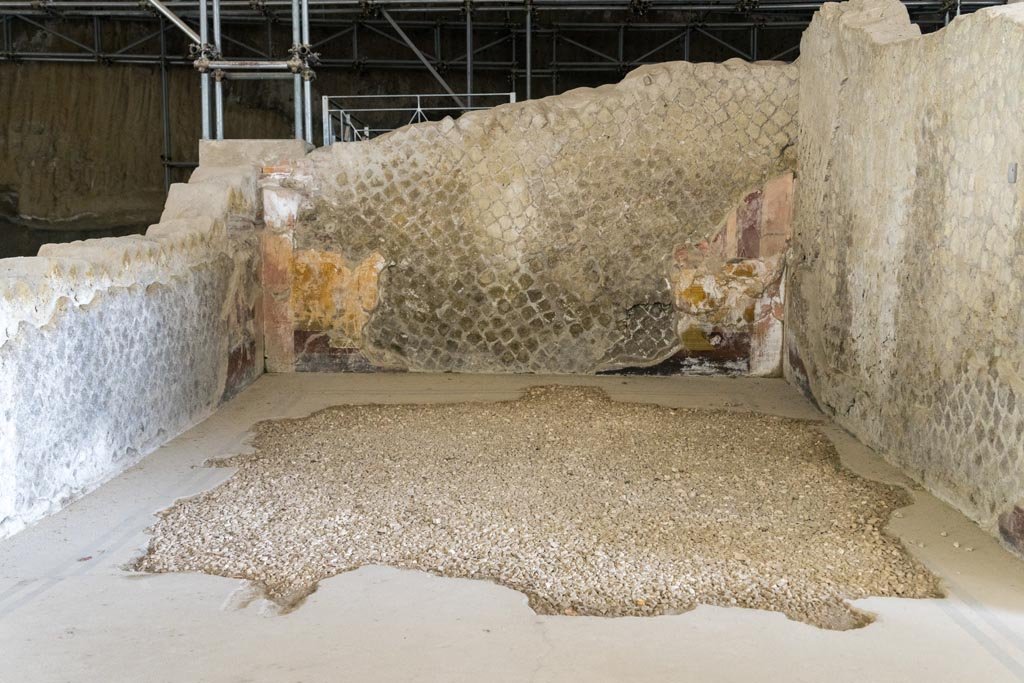
Herculaneum Villa dei Papiri. October 2023. Room (g), probably an oecus, looking north. Photo
courtesy of Johannes Eber.

Villa dei Papiri, March 2019. Room (g), detail from north-west corner.
Foto Annette Haug, ERC Grant 681269 DÉCOR.

Herculaneum Villa dei Papiri. October 2023. Room
(g), detail from north-east corner. Photo courtesy of Johannes Eber.

Villa dei Papiri, March 2019. Room (g), detail from north wall at east end.
Foto Annette Haug, ERC Grant 681269 DÉCOR.

Detail of painted decoration remaining on north wall in walkway (a), between room (b), on left, and room (g) on right.
Foto Annette Haug, ERC Grant 681269 DÉCOR.

Villa dei Papiri, March 2019. Detail from south side of walkway (a), opposite room (g).
Foto
Annette Haug, ERC Grant 681269 DÉCOR.

Herculaneum Villa dei Papiri. October
2023.
Looking west along large loggia/walkway (a) from
room (b), on right. Photo courtesy of Johannes Eber.

Villa dei Papiri, March 2019. Looking north towards room (b) and through to atrium (c), from large loggia (a).
Foto
Annette Haug, ERC Grant 681269 DÉCOR.

Villa dei Papiri, March 2019. Room (b), detail of doorway threshold at west end, looking north from large loggia (a).
Foto
Annette Haug, ERC Grant 681269 DÉCOR.

Villa dei Papiri, March 2019. Room (b), detail of doorway threshold at east end, looking north from large loggia (a).
Foto
Annette Haug, ERC Grant 681269 DÉCOR.

Herculaneum Villa dei Papiri. October
2023. Room
(b), looking north towards atrium (c). Photo courtesy of Johannes Eber.

Villa dei Papiri, March 2019. Room (b), looking south from atrium (c) across flooring towards the large loggia (a).
Foto
Annette Haug, ERC Grant 681269 DÉCOR.
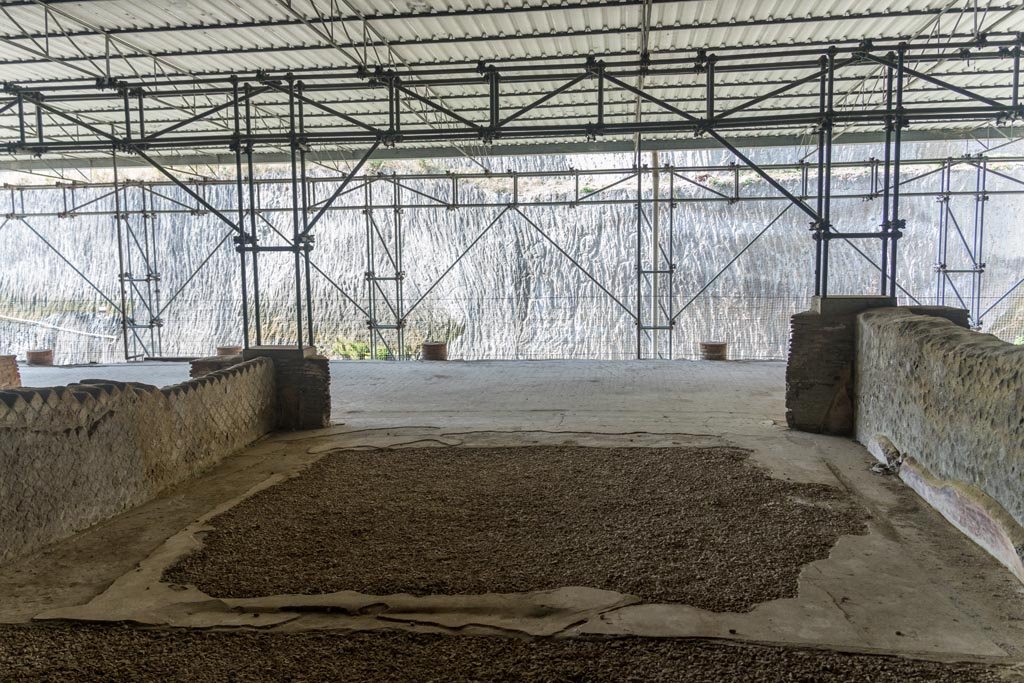
Herculaneum Villa dei Papiri. October 2023.
Room (b), looking
south across flooring towards the large loggia (a). Photo courtesy of Johannes Eber.
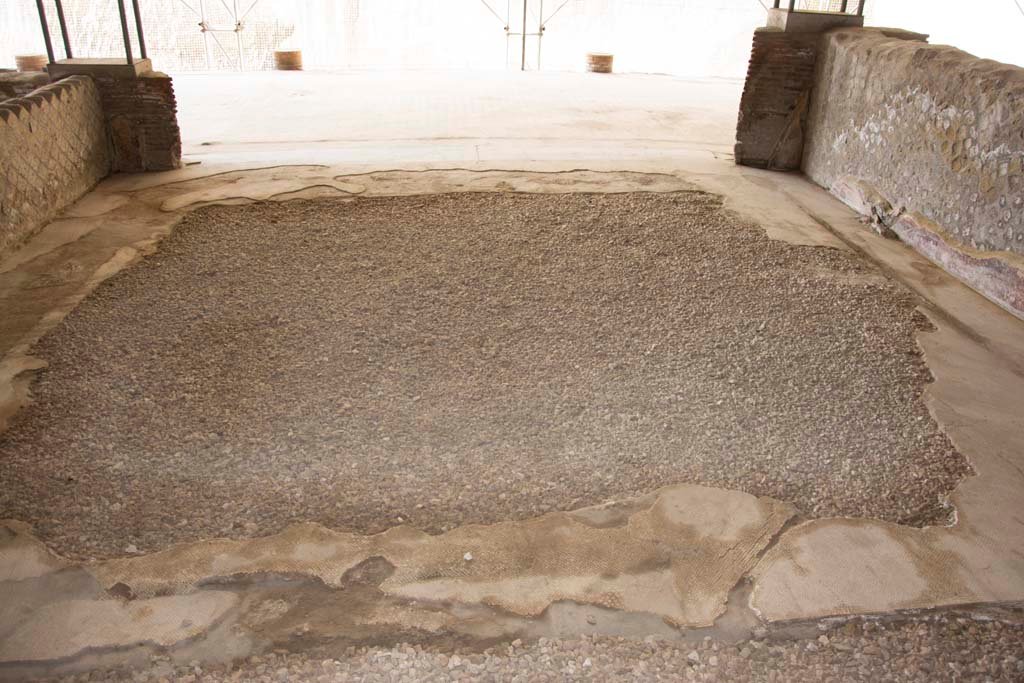
Villa dei Papiri, March 2019. Room (b), looking south across flooring towards large loggia (a).
Foto
Annette Haug, ERC Grant 681269 DÉCOR.

Herculaneum Villa dei Papiri. October
2023. Room (b), looking towards west wall from atrium
(c). Photo courtesy of Johannes Eber.
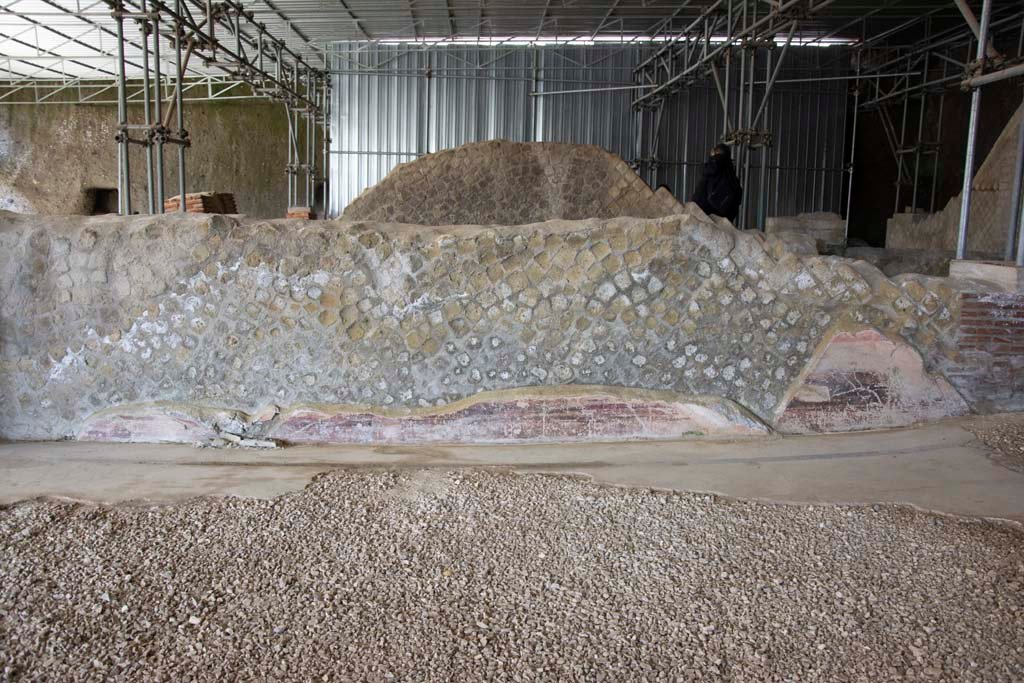
Villa dei Papiri, March 2019. Room (b), looking towards west wall with remaining painted decoration.
Foto
Annette Haug, ERC Grant 681269 DÉCOR.

Villa dei Papiri, March 2019. Room (b), detail of painted decoration on west wall.
Foto
Annette Haug, ERC Grant 681269 DÉCOR.
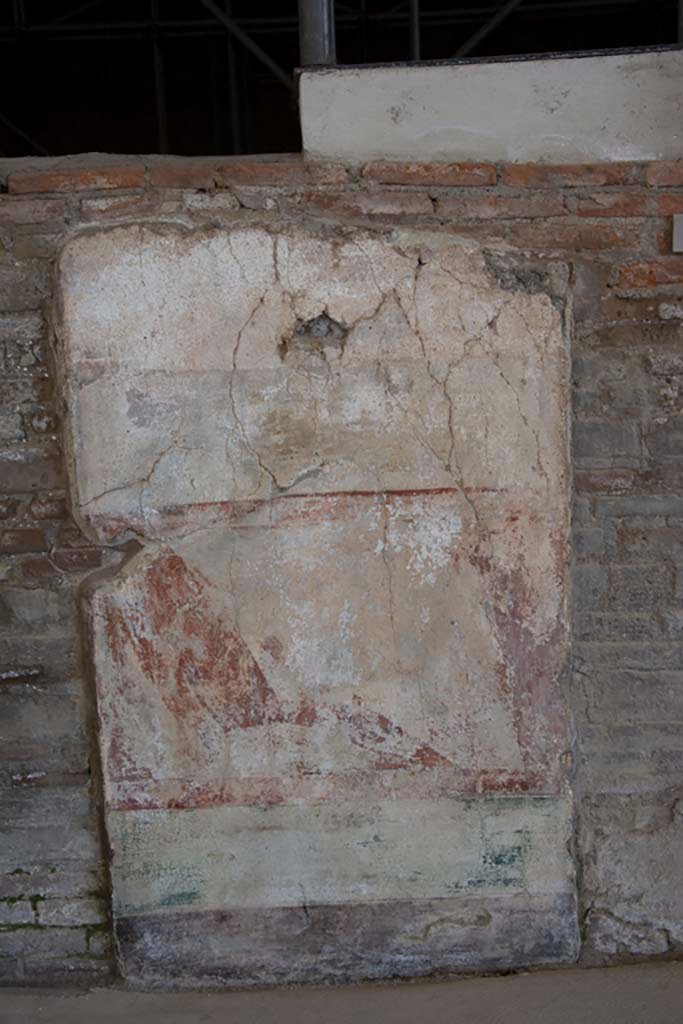
Villa dei Papiri, March 2019.
Detail of painted decoration on north wall of large loggia (a), between rooms (f), on left, and room (b), on right.
Foto Annette Haug, ERC Grant 681269 DÉCOR.
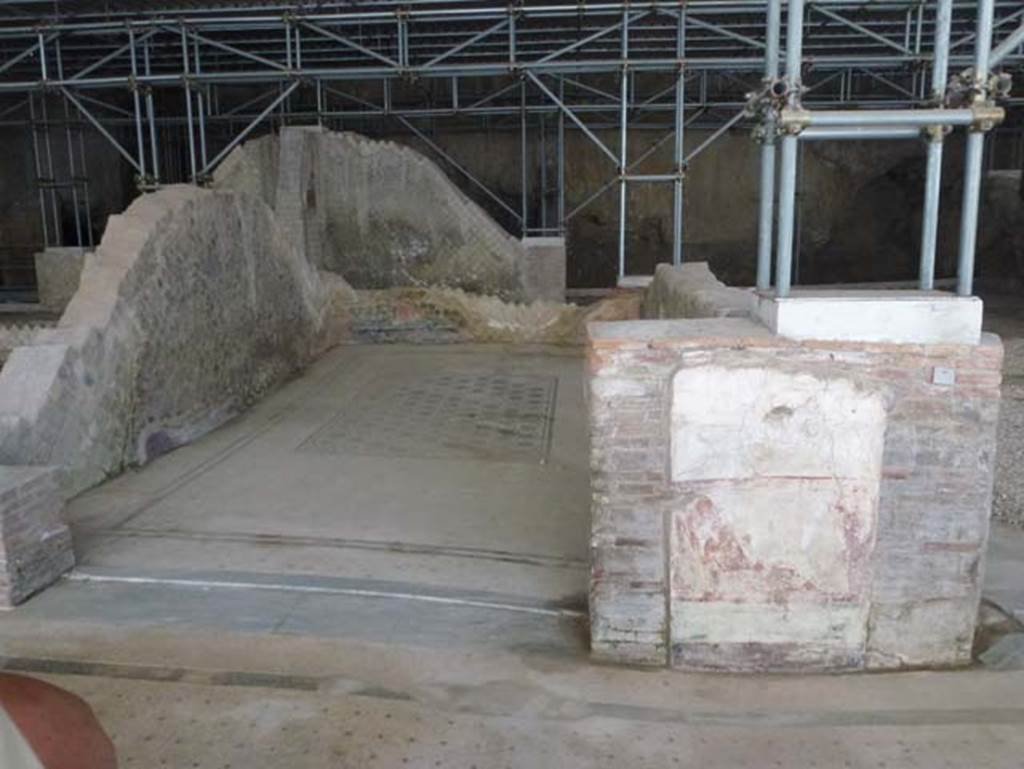
Villa dei Papiri, Herculaneum. June 2012. Doorway to room (f), oecus. Photo courtesy of Michael Binns.

Herculaneum Villa dei Papiri. October
2023. Room (f), looking north across oecus. Photo courtesy of Johannes Eber.

Villa dei Papiri, Herculaneum. July 2010. Looking north across room (f), oecus, from threshold. Photo courtesy of Michael Binns.

Herculaneum Villa dei Papiri. October
2023. Room (f), looking towards remains of north wall. Photo courtesy of
Johannes Eber.
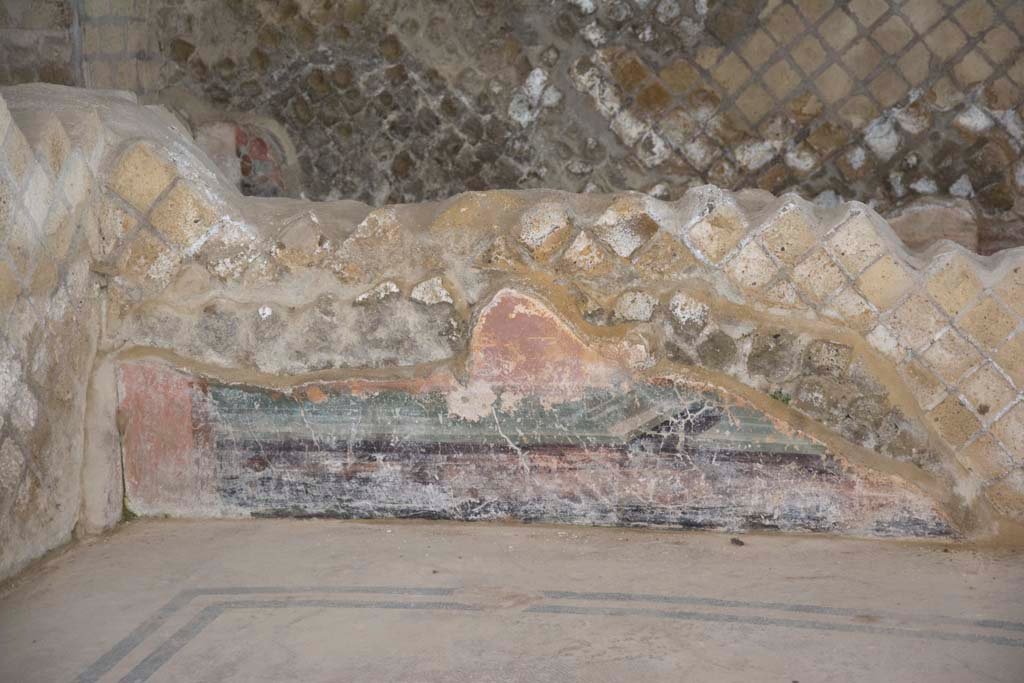
Villa dei Papiri, March 2019. Room (f), oecus, detail from north wall at west end.
Foto Annette Haug, ERC Grant 681269 DÉCOR.
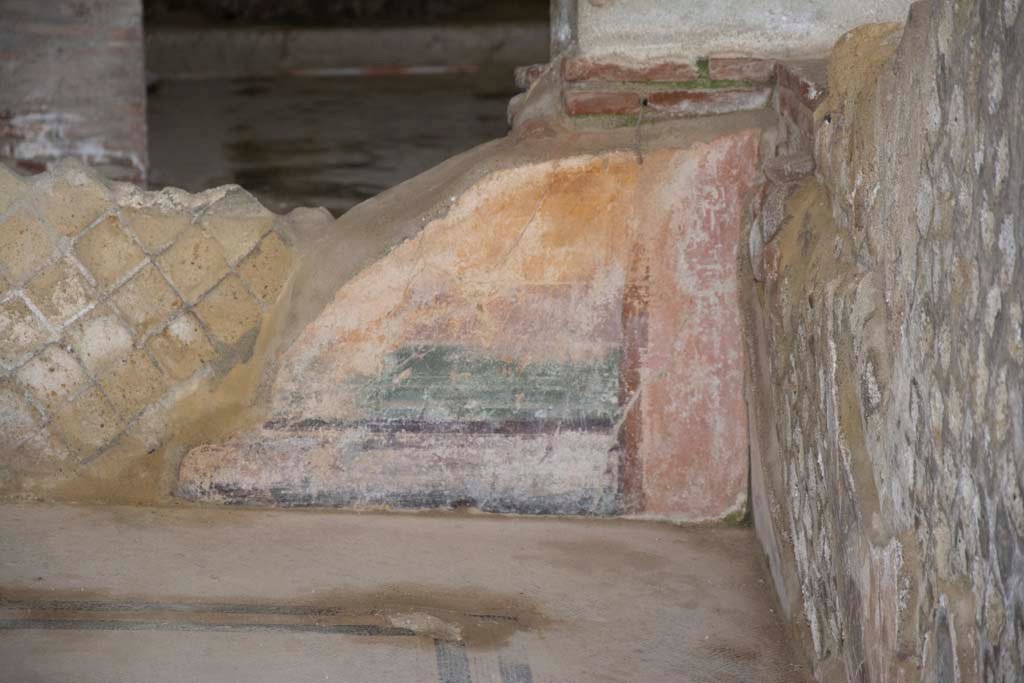
Villa dei Papiri, March 2019. Room (f), oecus, detail from north wall at east end.
Foto Annette Haug, ERC Grant 681269 DÉCOR.
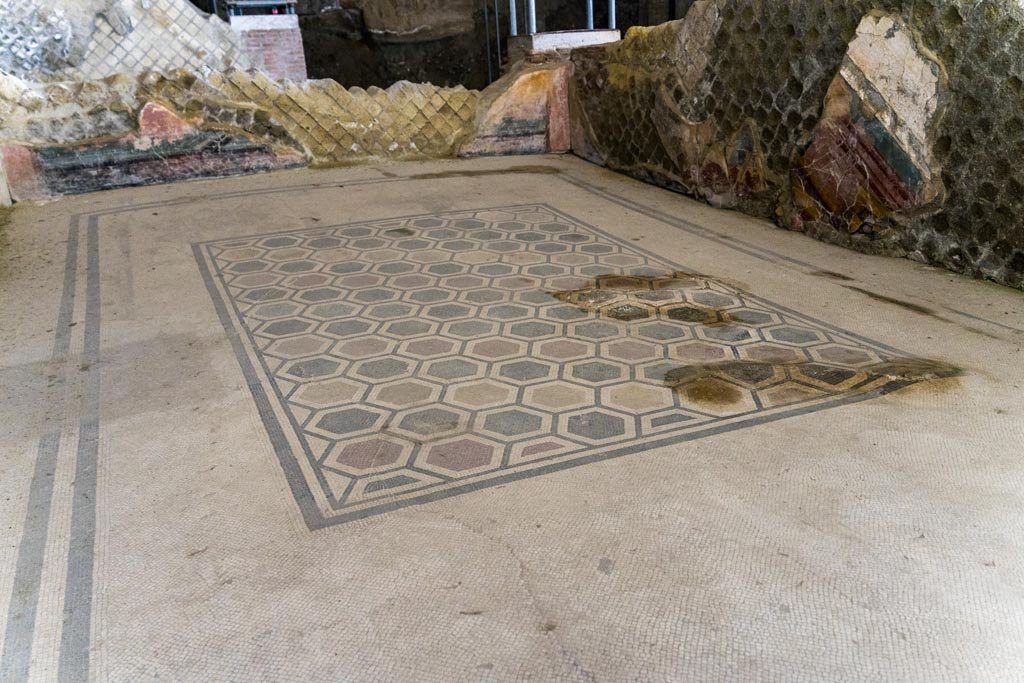
Herculaneum Villa dei Papiri. October
2023. Room (f), looking across flooring towards north-east corner. Photo
courtesy of Johannes Eber.
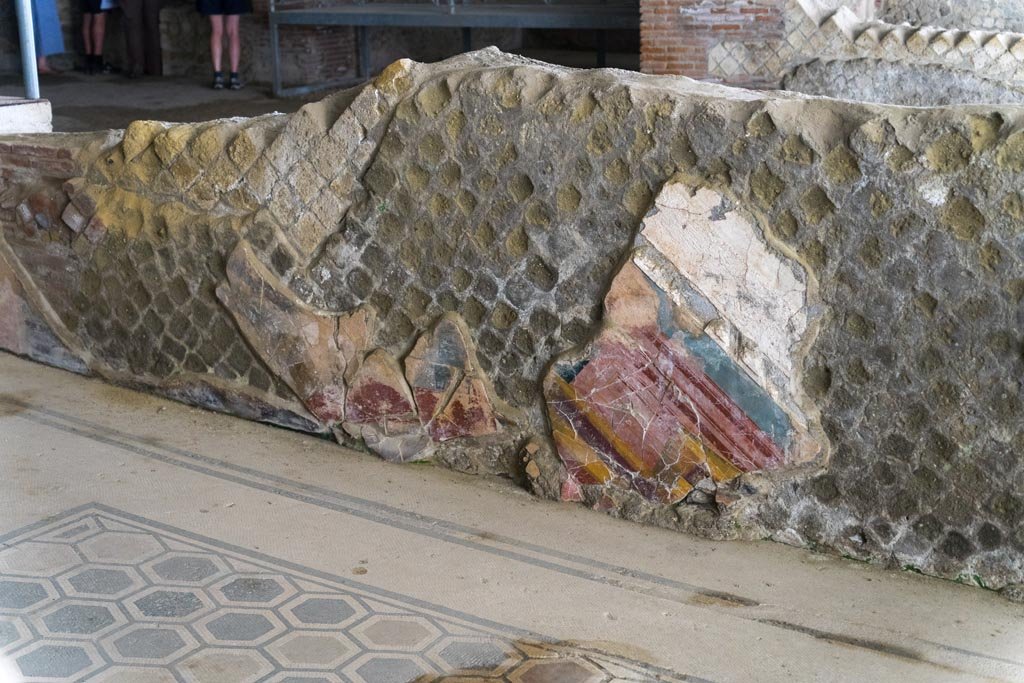
Herculaneum Villa dei Papiri. October
2023. Room (f), detail of remaining painted decoration on east wall. Photo
courtesy of Johannes Eber.

Villa dei Papiri, March 2019. Room (f), oecus, detail from east wall.
Foto Annette Haug, ERC Grant 681269 DÉCOR.

Herculaneum Villa dei Papiri.
October 2023. Room (f), looking north across flooring. Photo courtesy of Johannes
Eber.
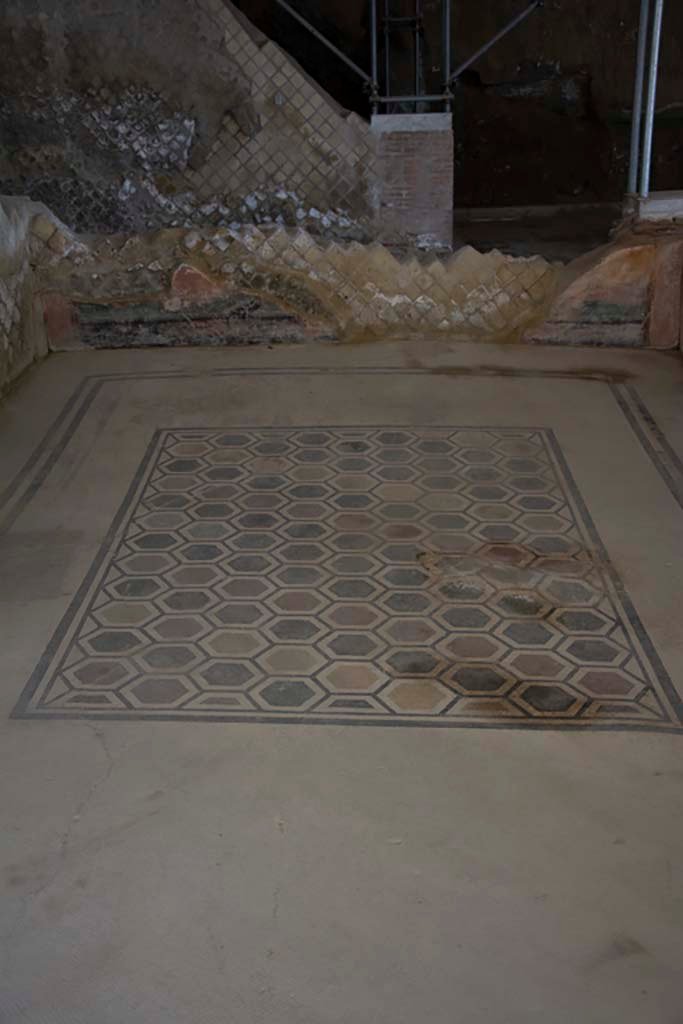
Villa dei Papiri, March 2019.
Looking north across multicolour geometric mosaic floor in room (f), oecus.
Foto Annette Haug, ERC Grant 681269 DÉCOR.
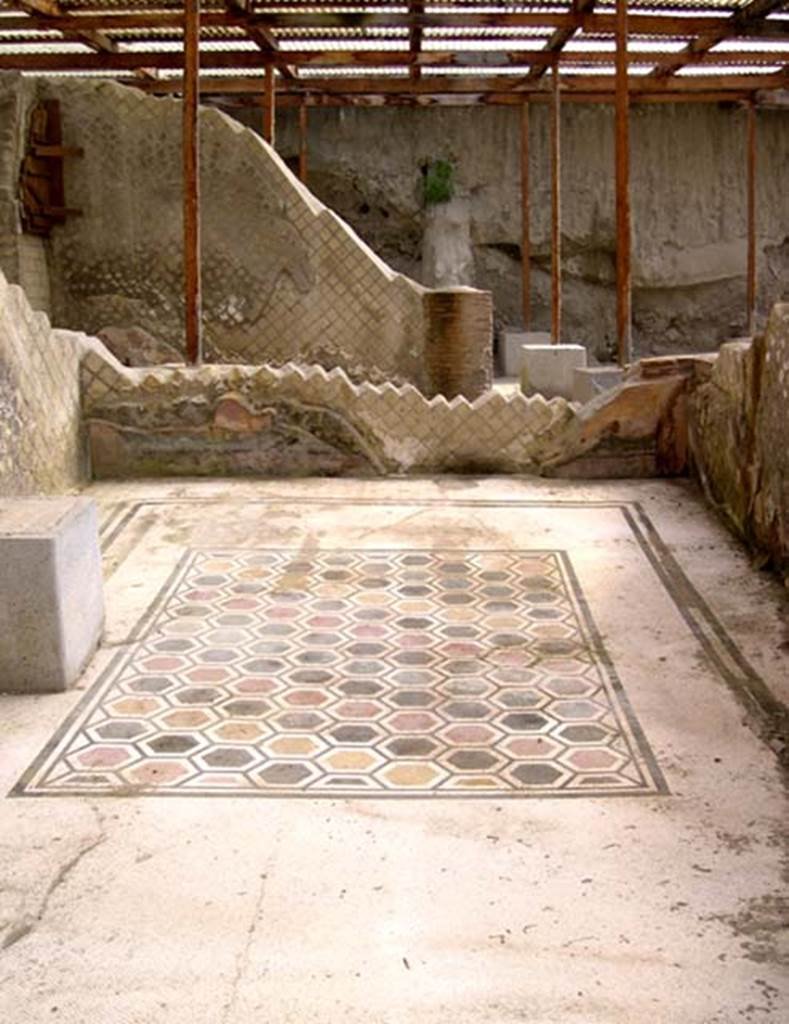
Villa dei Papiri,
Herculaneum. July 2004.
Looking north across multicolour geometric mosaic floor in room (f), oecus.
Photo courtesy of Jennifer Stephens. ©jfsPAP0671
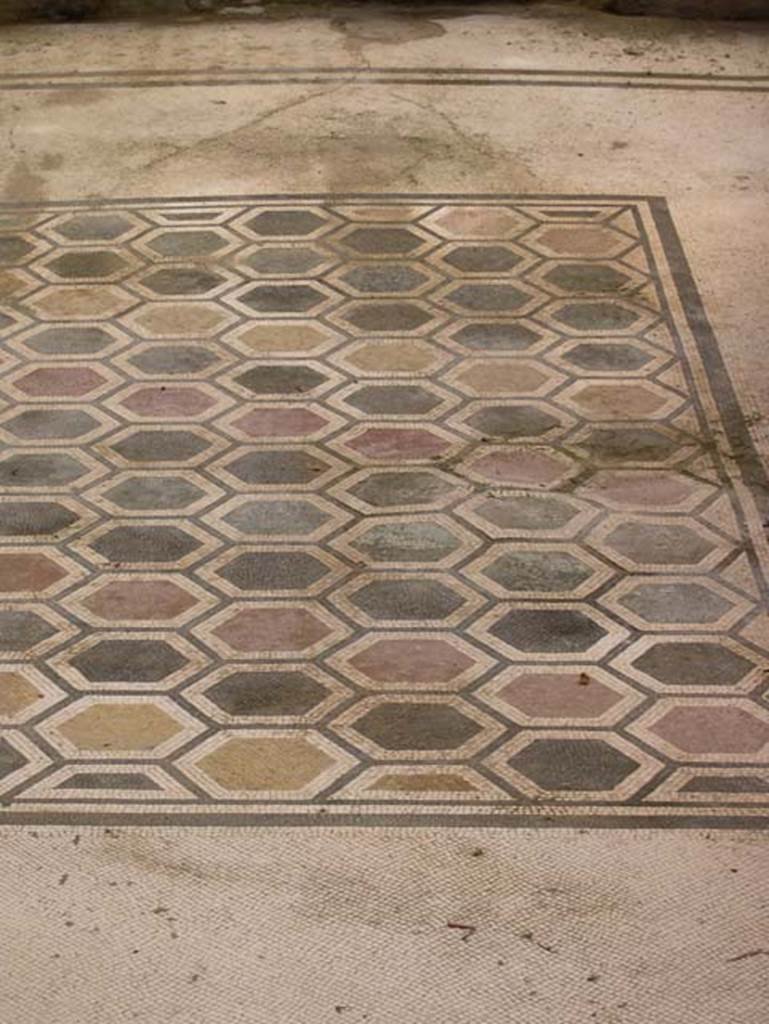
Villa dei Papiri, Herculaneum. July 2004. Detail of multicolour geometric mosaic floor in room (f), oecus.
Photo courtesy of Jennifer Stephens. ©jfsPAP0672

Herculaneum Villa dei Papiri. October
2023.
Looking east along north wall of walkway (a), the large loggia, from room (s), on left, with doorway into corridor (t).
Photo courtesy of Johannes Eber.
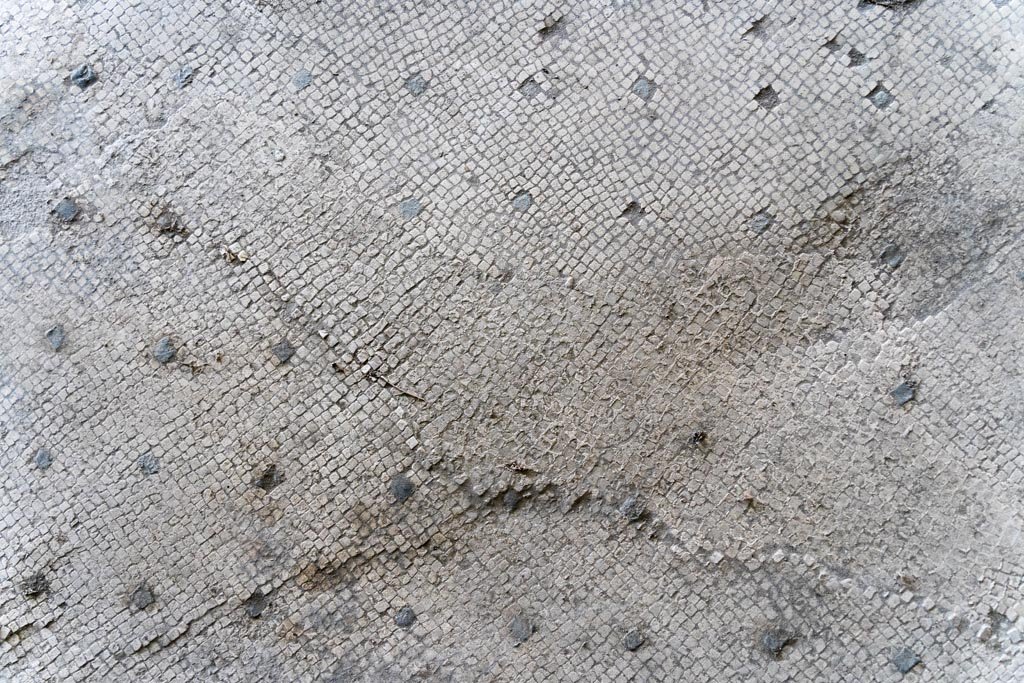
Herculaneum Villa dei Papiri. October
2023. Large loggia (a), black and white flooring. Photo courtesy of Johannes
Eber.

Villa dei Papiri, March 2019.
Looking east across walkway (a), the large loggia, with white and black mosaic floor.
Foto Annette Haug, ERC Grant 681269 DÉCOR.
Continued in Atrium part 2
Upper level Lower levels Reconstructions Getty Villa and the Jashemskis Model Monumental
structure Baths House of the Dionysiac
Reliefs and Pavilion Sculptures Frescoes Mosaics Plan
On this page: Bibliography Excavations The Villa dei Papiri complex Atrium part 1 Atrium part 2
